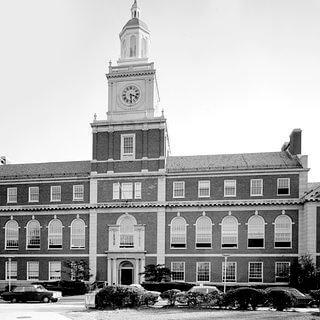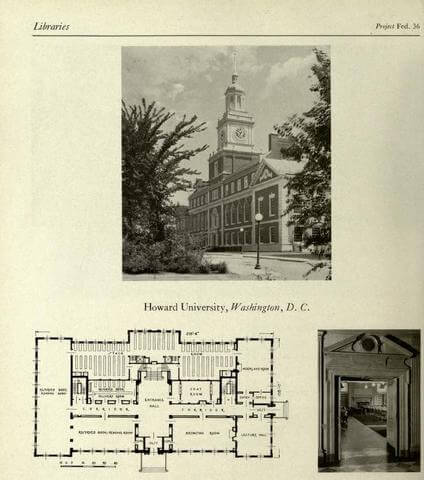History
How The Founders Library Came To Be...
The Beginning
Discussions related to building a state-of-the-art library on the main campus of Howard University began in 1929. In that year, the U.S. Congress appropriated $1 million for the construction of the library. At the time, the university's library collection was housed in the Carnegie Library also located on the main campus. Opened in 1910, the Carnegie Library allowed for the expansion of the library collection, which facilitated its use. Prior to this period, the library collection was scattered between the main building and individual libraries in each college. By 1929, the collection had grown to over 85,000 volumes and continued expanding through yearly appropriations of $4,000. The building also housed the Moorland Collection of over 3,000 documents related to African and African American history donated in 1914 by Howard Trustee and YMCA executive Jesse E. Moorland. Due to its continued growth, the Carnegie Library was strained by usage at the time. Thus, a new library was commissioned.
Making A Space For History
Although funds were appropriated for construction in 1929, construction did not actually begin until 1936. To accommodate its construction, the original main building on the campus was demolished. In addition, the President's house, which sat next to the main building was moved. Upon its completion, Founders Library received national attention. It was described as a "palace of books" and was the most comprehensive library at any Historically Black College or University. On Founders’ dedication in May 1939, U.S. Secretary of the Interior Harold Ickes, who was prominent in securing the funding for the library, said this of the importance of libraries:
A library is more than a building, it is more than the volumes that rest upon its shelves...We can hardly over-estimate the role of libraries in modern life. They constitute perhaps the most important single agency for the perpetuation of civilization. To the libraries we entrust for safe keeping our accumulated social, artistic and scientific knowledge. It is upon their resources that we largely depend for knowing and understand[ing] the past; it is by their help that we may undertake to absorb the knowledge and develop the intellectual habits necessary for effective participation in the democratic way of life; and it is mainly through them that we hope to be able to project our own contributions into and influence the future. (Mekkawi, Mohamed (2009). "Alber I. Cassel & The Founders Library: A Brief History.")
The Architectural Process
Albert Cassell's firm makes clear how the project began: The university was fairly specific. They gave us the names and the sizes for the principal spaces, and the number of books that they wanted to provide for. They suggested that this building have a tower. Old Main Building had one. The site given was on top of the hill where the Old Main Building sat. It would have to go and the president's house would have to be moved.
We found that a building about 200 feet long by 100 feet wide would do if we made the building four healthy stories high and provided for six levels of stacks...The tower should be exactly in the center and should read as a tower from the north campus (the larger, more prominent campus).
The tower was borrowed from Independence Hall in Philadelphia. Since it was dedicated to liberty we felt that we could do no better.
From these design parameters came a structure of striking nobility. When it was dedicated on May 25, 1939, The Founders Library opened to rave reviews. Newspaper headlines shouted, "Howard Memorial to Founders Is Like Aladdin's Palace." No detail was too small to escape notice.
The sound proofed walls and ceilings enable readers to talk in one corner of the room without being heard in the other. Floors are of cork and rubber, $1,000 rugs so deep readers will sink in to their ankles.
There are five reading rooms, the main one 120 feet by 32 feet, equipped with twenty silver oak tables each having six chairs. Overhead the ceiling carries... indirect lights of 500 watts each. So efficient is the lighting that if an obstruction is held 2 feet above a book, enough light will still come in at the side to permit easy reading.
The browsing room is fitted with cream colored monk's cloth drapes, Spanish leather easy chairs and couches and Axminster rugs that cost $1,000 each. (Id.)
A National Treasure
The Founders Library is a Georgian style, red brick building with a clock tower visible throughout Washington, D.C. The building contained many of the most advanced technological advancements of the day including mechanical elevators and air conditioning. Founders Library cost slightly over $1 million in 1939 and was one of the most important academic structures of the 1940's.
The importance of the structure was recognized 73 years later when in 2012 the Founders Library was named a "national treasure" by the National Trust for Historic Preservation. (Douglas-Gabriel, Danielle (February 29, 2016). "Howard University's Founders Library Named a National Treasure." The Washington Post).
The Founders Library Today
Today, the Howard University Libraries—a central library system consisting of Founders, three additional branches in the schools of Business, Divinity, and Social Work, and the renowned Moorland-Spingarn Research Center—is truly more than the volumes that rest upon its shelves. All of our libraries and centers are dedicated to supporting the curricula and educational mission of Howard University. They offer a remarkable collection of over three-quarters of a million book and journal titles, electronic and multimedia resources, and over two hundred online databases on topics ranging from African Studies to Life Sciences, Theatre Arts, and World Languages.
The Howard University library system takes pride in the many instructional classes we provide and in the diverse resources we make available to facilitate the research and learning experiences of students, faculty, and the general public. Our staffs are dedicated to providing the highest level of service to all patrons.
We are especially proud of our Moorland-Spingarn Research Center collection and the University Archives and Museum, all of which are housed in Founders Library. What began in the early years of Howard University as a small collection of antislavery books and pamphlets is now one of the world’s premiere centers for the study of the Black experience. It has made possible new research and enabled scholars to probe more deeply into the complexities of Black history and culture.
Please make use of the print and electronic resources that the Howard University Libraries have to offer. Whether you contact us by chat, Twitter, Facebook, email, our website, or stop by the library, we hope that your visit with us will be a rewarding experience.




